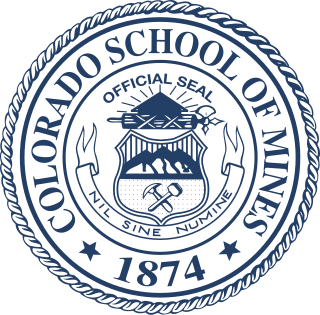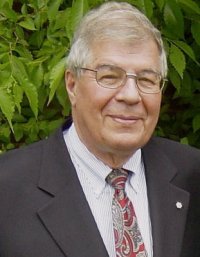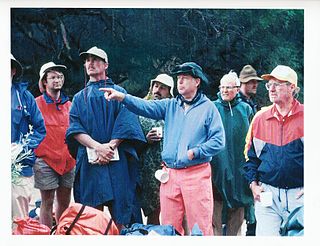This article needs additional citations for verification .(February 2024) |
This is a list of some notable people associated with the Colorado School of Mines , located in Golden, Colorado, United States.
This article needs additional citations for verification .(February 2024) |
This is a list of some notable people associated with the Colorado School of Mines , located in Golden, Colorado, United States.

Colorado School of Mines (Mines) is a public research university in Golden, Colorado founded in 1874. The school offers both undergraduate and graduate degrees in engineering, science, and mathematics, with a focus on energy and the environment. While Mines does offer undergraduate minor programs in the humanities, arts, and social sciences, it only offers degree programs in STEM fields, with the exception of economics. In the Fall 2023 semester, the school had 7,101 students enrolled, including 5,443 undergraduate and 1,658 graduate students. The school has been coeducational since its founding but enrollment remains predominantly male. It is classified among "R1: Doctoral Universities – Very high research activity".

The Royal School of Mines comprises the departments of Earth Science and Engineering, and Materials at Imperial College London. The Centre for Advanced Structural Ceramics and parts of the London Centre for Nanotechnology and Department of Bioengineering are also housed within the building. The school as an organisation no longer exists, having been incorporated into the Faculty of Engineering since 2003. Today the Royal School of Mines refers to both the departments associated with the former school, and the Grade II listed Edwardian building by Sir Aston Webb, which is viewed as a classic of academic architecture. The building and relevant student union still carry the name.

The Fu Foundation School of Engineering and Applied Science is the engineering and applied science school of Columbia University, a private research university in New York City. It was founded as the School of Mines in 1863 and then the School of Mines, Engineering and Chemistry before becoming the School of Engineering and Applied Science. On October 1, 1997, the school was renamed in honor of Chinese businessman Z.Y. Fu, who had donated $26 million to the school.

Arden Lee Bement Jr. is an American engineer and scientist and has served in executive positions in government, industry and academia.

Raymond Alexander Price, is a Canadian geologist. He has used his research on the structure and tectonics of North America’s lithosphere to produce extensive geological maps. He has also provided guidance for nuclear fuel waste disposal and reports on the human contribution to Global warming.

Fred F. Meissner was an American geologist and engineer who contributed to the fields of geology, geophysics, engineering, petroleum engineering, geochemistry, mineralogy, physics, mining, economic geology, and fishing.

Shane Bannister Carwin is an American former mixed martial artist who competed in the Heavyweight division of the Ultimate Fighting Championship (UFC). He is a former Interim UFC Heavyweight Champion. He is considered to be one of the hardest hitting athletes to ever fight in the UFC.

William Embry Wrather was an American petroleum and economic geologist who served in various administrative roles including as director of the U.S. Geological Survey (USGS). He was awarded the John Fritz Medal in 1954.
William John Arbegast, Jr. was an American metallurgical engineer, mechanical engineer and friction stir welding expert.
James Vladimir Taranik was an American scientist and educator who worked in the area of earth-observation satellite remote sensing. He was Chief of NASA's Non-Renewable Resources Branch and Program Scientist of the Space Shuttle's first scientific flights with cargo that included experiments related to geology, atmospheric chemistry, meteorology, marine biology, and plant physiology in the earth and life sciences. He also held various positions in the Nevada System of Higher Education, including the Desert Research Institute and the Mackay School of Earth Sciences and Engineering.
Terri S. Hogue is an American hydrologist. She is currently a professor and department head of Civil and Environmental Engineering at Colorado School of Mines. Her research focuses on different hydrologic and land surface processes in semi-arid regions and the implications of them on water resource management.

Kamini Singha is a Professor in the department of Geology and Geological Engineering at the Colorado School of Mines, where she works on questions related to hydrogeology.
Ye Zhupei or Yap Chu-Phay was a Chinese physical chemist, chemical engineer, and metallurgist. Born into an overseas Chinese family in the Philippines and educated in the United States, he moved to China in the 1930s and served in both the Kuomintang and the Communist governments. Considered the founder of chemical metallurgy in China, he was elected a founding member of the Chinese Academy of Sciences (CAS) in 1955 and established the Institute of Chemical Metallurgy of the CAS in 1958. He was persecuted during the Cultural Revolution and died in prison after five years of incarceration.
T. A. Rickard, formally known as Thomas Arthur Rickard, was born on 29 August 1864 in Italy. Rickard's parents were British, and he became a mining engineer practising in the United States, Europe and Australia. He was also a publisher and author on mine engineering subjects.

Geological engineering is a discipline of engineering concerned with the application of geological science and engineering principles to fields, such as civil engineering, mining, environmental engineering, and forestry, among others. The work of geological engineers often directs or supports the work of other engineering disciplines such as assessing the suitability of locations for civil engineering, environmental engineering, mining operations, and oil and gas projects by conducting geological, geoenvironmental, geophysical, and geotechnical studies. They are involved with impact studies for facilities and operations that affect surface and subsurface environments. The engineering design input and other recommendations made by geological engineers on these projects will often have a large impact on construction and operations. Geological engineers plan, design, and implement geotechnical, geological, geophysical, hydrogeological, and environmental data acquisition. This ranges from manual ground-based methods to deep drilling, to geochemical sampling, to advanced geophysical techniques and satellite surveying. Geological engineers are also concerned with the analysis of past and future ground behaviour, mapping at all scales, and ground characterization programs for specific engineering requirements. These analyses lead geological engineers to make recommendations and prepare reports which could have major effects on the foundations of construction, mining, and civil engineering projects. Some examples of projects include rock excavation, building foundation consolidation, pressure grouting, hydraulic channel erosion control, slope and fill stabilization, landslide risk assessment, groundwater monitoring, and assessment and remediation of contamination. In addition, geological engineers are included on design teams that develop solutions to surface hazards, groundwater remediation, underground and surface excavation projects, and resource management. Like mining engineers, geological engineers also conduct resource exploration campaigns, mine evaluation and feasibility assessments, and contribute to the ongoing efficiency, sustainability, and safety of active mining projects
James Boyd was an American mining engineer and educator. He led the Metals and Minerals Branch of the Commodities Division of the Army–Navy Munitions Board during World War II and served as the 8th director of the U.S. Bureau of Mines.
Walter Hull Aldridge was an American mining and metallurgical engineer. He was a recipient of the William Lawrence Saunders Gold Medal and the John Fritz Medal.
Eben Erskine Olcott was an American mining engineer. He was president of the Hudson River Day Line and served as two-time president of the American Institute of Mining, Metallurgical, and Petroleum Engineers in 1901–02.